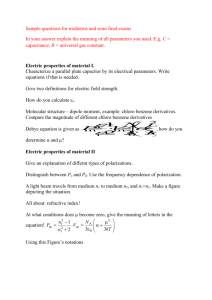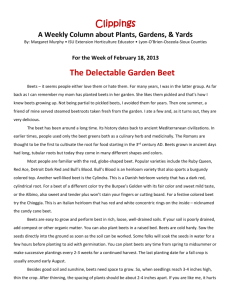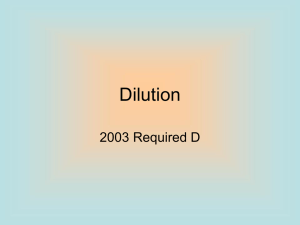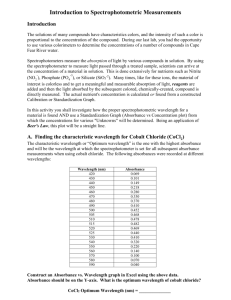PROJECT PROPOSAL COVER PAGE
advertisement
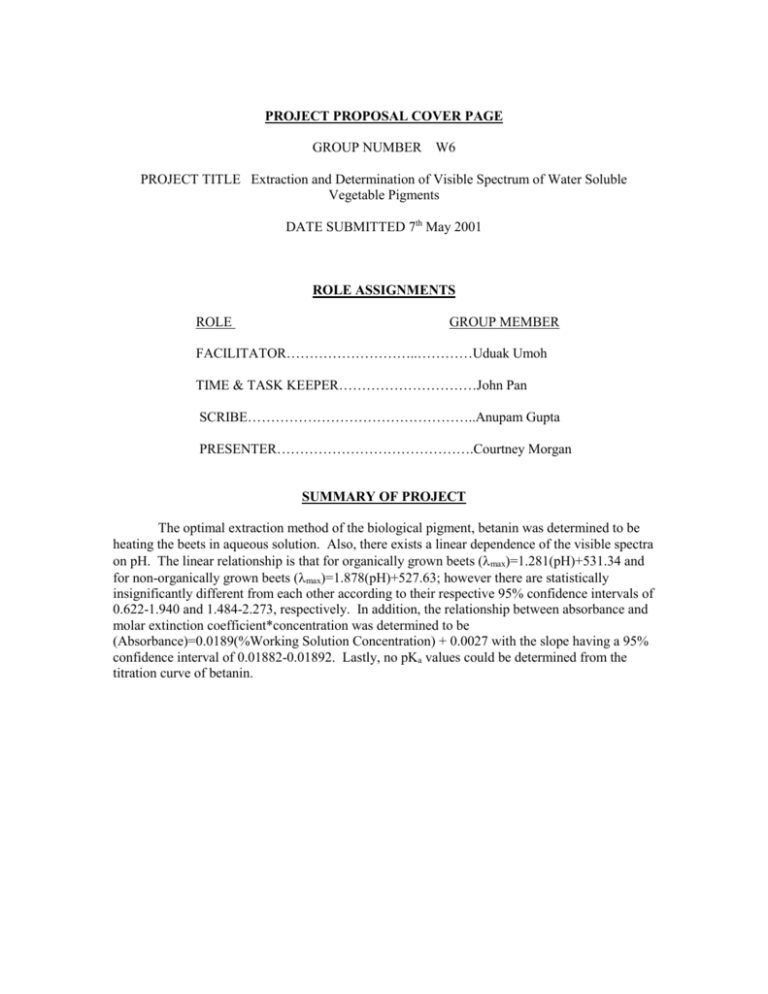
PROJECT PROPOSAL COVER PAGE GROUP NUMBER W6 PROJECT TITLE Extraction and Determination of Visible Spectrum of Water Soluble Vegetable Pigments DATE SUBMITTED 7th May 2001 ROLE ASSIGNMENTS ROLE GROUP MEMBER FACILITATOR………………………..…………Uduak Umoh TIME & TASK KEEPER…………………………John Pan SCRIBE…………………………………………..Anupam Gupta PRESENTER…………………………………….Courtney Morgan SUMMARY OF PROJECT The optimal extraction method of the biological pigment, betanin was determined to be heating the beets in aqueous solution. Also, there exists a linear dependence of the visible spectra on pH. The linear relationship is that for organically grown beets (max)=1.281(pH)+531.34 and for non-organically grown beets (max)=1.878(pH)+527.63; however there are statistically insignificantly different from each other according to their respective 95% confidence intervals of 0.622-1.940 and 1.484-2.273, respectively. In addition, the relationship between absorbance and molar extinction coefficient*concentration was determined to be (Absorbance)=0.0189(%Working Solution Concentration) + 0.0027 with the slope having a 95% confidence interval of 0.01882-0.01892. Lastly, no pKa values could be determined from the titration curve of betanin. Proposed Specific Aims: One property of biological pigments that can be studied is the absorption of light at specific wavelengths and the reflection of light in the visible spectrum that accounts for the characteristic color of the pigments. The objective of this experiment is to determine the most effective extraction method for the betanin pigment present in beets, to measure the pH dependence of absorption in the visible spectra, and to determine the titration curve for betanin using 0.01 M HCl and NaOH. Background: Betanin is the primary pigment found in the roots of table beets that accounts for about 75-95% of the total coloring matter found in beets (3). Betanin is an anthocyan that implies that is a water-soluble pigment that imparts colors ranging from violet and blue to most shades of red. In addition, betanin exists as an internal salt or as a zwitterion in the vacuoles of beets. The carboxyl and amine groups present in the structure account for the four pKa values. The structure of betanin is shown in Figure 1 (3). Betanin (molecular weight =564g/mol) is an important pigment to analyze because it is used as a food colorant and since foods come at variant pH, the behavior of betanin at various pHs is important. Figure 1: Structure of betanin Literature data show that the maximum absorption peak of betanin occurs at a wavelength of 538 nm at a pH of 5. Figure 2 shows a plot of the absorption versus wavelength for betanin at pHs of 2, 5, and 9 (2). Furthermore, this plot also shows the difference in the maximum absorption values for the three different pHs when the betanin sample is stored for zero and seven days at 4C. It is determined through graphical analysis that the maximum absorbance peaks for betanin at pHs of 2 and 9 decrease as time increases and they also tend to converge towards the same absorbance value. In addition, for the pH dependence of the visible spectrum, below a pH of 3.5, the absorbance maximum occurs at 535 nm; as the pH falls below 3, the color of the betanin shifts towards violet (2). Between pH of 3.5 and 7.0, the absorbance maximum occurs at 538 nm (2). Lastly, at pH values above 9.0, the absorbance maximum occurs at 544 nm and the color of the betanin shifts towards more blue (2). Figure 2: Absorbance versus wavelength in the visible spectra for betanin at pH values of 2, 5, and 9. Materials and Apparatus: Corning Hot Plate Corning Temperature Thermostat Proctor Silex Blender Non-organically and Organically Grown Table Beets from Fresh Fields Cheesecloth Dialysis Tubing Low Temperature Oven International Equipment Company Ultracentrifuge PR-7000 Solutions for Universal Buffer M Citric Acid 0.4 0.002 M HCl 0.4 0.002 M NaOH 0.1 M Potassium Chloride 0.1 M Potassium Phosphate 0.1 M Sodium Tetraborate 0.1 M Tris Methods: This experiment essentially required two different protocols. The first protocol was in the extraction of the betanin from the table beets. The second protocol was in the determination of the visible spectrum dependence of pH and the titration of the betanin. The first protocol involved the extraction of the pigment via three various methods. Three 2cm3 cubes of beetroot were cut out from the center of the table beet. Each cube was chopped into thin slices using a knife and then divided into separate masses of the original cube. One sample was placed inside the low temperature oven overnight for the dry weight mass to be found the following day. The other sample underwent one of the three extraction methods. All extraction methods were performed using a buffer solution of pH 5. The buffer solution was made using the universal buffer protocol as outlined below: A 1.0 L universal buffer solution was made by mixing the five salts listed in Table 1 into a 1.0 L volumetric flask (4) using deionized water. Mass (g) Chemical 22.81 Citric acid • H2O (Lot #: 986289) 13.61 Potassium phosphate Monobasic Anhydrous 28.07 Sodium tetraborate • 10H2O (Lot#: 975696) 12.11 Tris Hydroxymethyl Aminomethane (Lot#: 986492A) 7.46 Potassium chloride (Lot#: 922583B) Table 1: Mass of the chemicals added to get the universal buffer. The pH of the 1.0 L universal buffer solution was adjusted by adding approximately 0.4 ml (4) of 1.0 M HCl (Lot#: 003398-24) until the pH reached 5.0. The first extraction method was to add the chopped beetroot into the Proctor Silex Blender and then add 100 ml of the pH 5 buffer. The chopped beetroot was blended on the ‘liquefy’ setting for one minute. The second extraction method was to add the chopped beetroot sample to 100ml of the pH 5 buffer and then heat using a Corning hot plate and temperature thermostat to maintain a constant temperature at 50C for 10 minutes (1). The third extraction method was to first heat in 100 ml of pH 5 buffer then blend the heated sample. The solutions for each of these methods were transferred into 50 ml Falcon Tubes that were then centrifuged for 10 minutes at 2500 rpm. Using cheesecloth, the solids were separated from the supernatant in the solution, and the solution was centrifuged and filtered through cheesecloth again. 50% of each sample was dialysized using dialysis tubing in an attempt to remove sugars from the solution. 10ml of each sample was saved for use in the rest of the experiment after determination of the best extraction method. The rest of the sample was placed into the low temperature oven. The absorption spectrum, color, and pH of the dialysized samples were checked the following day and 90% of the dialysized sample was placed into the low temperature oven and the rest was saved. In addition, the mass of the dried beetroot samples was taken the following day on the basis of a constant mass. After the best extraction method was determined, the saved samples was divided into five different samples and the pH was altered to 2 and 3, and 7 and 9 using 0.010.0002 M HCl and NaOH, respectively. A spectral scan from 300 to 800 nm was run on the different pH samples. Using the best extraction method sample, dilutions of 10, 20, 30, 40, 50, 60, 70, 80, 90, 100% were made using pH 5 buffer and the absorption level was taken at 537 nm to determine the molar extinction coefficient with respect to the concentration. Using the best extraction method, betanin was extracted from two beetroots in deionized water instead of pH 5 buffer solution. The betanin sample was then centrifuged and filtered through cheesecloth. The filtrate was then titrated using 0.010.0002 M HCl and NaOH. Results: Figure 3 shows the spectral scan for the non-organically grown beets before the betanin samples were dialysized. It is apparent that there is a broad absorption peak between 400 and 600 nm in the ‘heated and blended’ sample that occurred because the Spectronic Genesys 5 Spectrophotometer is not suitable for measuring absorbance levels as high as 3.2. 3.5 Heated and Blended Absorbance 3 Figure 3: Non-organically grown betanin samples extracted via the three different methods. 2.5 2 Blended 1.5 1 0.5 Heated 0 0 200 400 600 800 1000 Wavelength (nm) Absorbance Figures 4 and 5 show the spectral scans for non-organically and organically grown beets, respectively, after dialysis. From graphical analysis, the ‘heated and blended’ sample for the nonorganically growth beets does show an absorption peak where the peak for betanin was expected to occur, around 537 nm; furthermore, there is no peak evident for the organically grown beets ‘heated and blended’, thus it can be determined that for the ‘heated and blended’ sample, the betanin molecule simply passed through the dialysis membrane. For both graphs of the ‘heated’ sample, there is an apparent peak where it was expected, around 537 nm. 0.5 0.45 Heated and Blended 0.4 0.35 0.3 0.25 Blended 0.2 0.15 Heated 0.1 0.05 0 250 350 450 550 Figure 4: Spectral scans for the non-organically grown betanin extract after dialysis. 650 Wavelength (nm) 750 850 1.8 1.6 Heated and Blended Absorbance 1.4 1.2 Figure 5: Spectral scan for the organically grown betanin extract after dialysis. Blended 1 0.8 0.6 0.4 Heated 0.2 0 250 350 450 550 650 750 850 Wavelength(nm) Figures 6 and 7 show the spectral scans for the non-organically and organically grown beets, respectively, before dialysis at various pHs of 2, 3, 5, 7, and 9 with the maximum wavelength shown. It is apparent that the absorption levels are much lower for pHs of 2, 3, 7, and 9 than the original sample at pH 5. This is because these samples were prepared by diluting with HCl or NaOH. In the non-organically grown betanin sample, the amounts of HCl and NaOH used were much more than those used in preparing the organically grown betanin samples. 0.9 Figure 6: Spectral scan for nonorganically grown beets at different pHs of 2 (Blue line), 3 (Purple line), 5 (Green line), 7 (Orange line), and 9 (Pink line). 537 0.8 A bsorbance 0.7 0.6 0.5 0.4 0.3 540 534 531 545 0.2 0.1 0 350 400 450 500 550 600 650 700 Wav e le ngth (nm) Figure 7: The spectral scan for organically grown beets at different pHs of 2 (Blue line), 3 (Purple line), 5 (Green line), 7 (Orange line), and 9 (Pink line). Table 2 lists the literature values for the maximum wavelength and the max found for the non-organically and organically growth beets with the percent deviances. pH Literature Non-organic Organi % Deviance for % Deviance Non-organic for Organic max max c max 534 531 534 -0.562 % 0.00 % 2 534 536 3 537 537 537 0.00 % 0.00 % 5 540 539 7 544 545 544 0.184 % 0.00 % 9 Table 2: Maximum wavelengths and their percent deviance from the literature values for both non-organically and organically grown beets. Figure 8 shows the graph of the pH versus the max for the literature values and nonorganically and organically grown beets. For organically grown beets, the slope of the linear regression, 1.281, has a 95% confidence interval of 0.622 to 1.940; for the non-organically grown beets, the slope of the linear regression, 1.878, has a 95% CI of 1.484 to 2.273. For the literature values, the slope of the linear regression, 1.446, has a 95% CI of -1.231 to 4.123. 548 Wavelength (nm) 546 Literature y = 1.4459x + 530.62 Organic 2 y = 1.2805x + 531.34 R = 0.9792 544 542 540 R2 = 0.9272 538 536 534 Inorganic y = 1.878x + 527.63 R2 = 0.9871 532 530 528 0 2 4 pH 6 8 10 Figure 8: pH versus max. Absorbance Figure 9 shows a plot of the absorbance versus % working solution concentration. The 95% CI of the slope is 0.01882 – 0.01892. Additionally, the R2 value of the linear regression is 0.9999 and the p-value of the regression is 5.93*10-21. The following relationship can be determined between the molar extinction coefficient and concentration of a sample: Absorbance = 0.0189*(%working solution) = *C. 2 1.8 1.6 1.4 1.2 1 0.8 0.6 0.4 0.2 0 Figure 9: Absorbance versus % working solution. y = 0.0189x - 0.0027 R2 = 1 0 10 20 30 40 50 60 % Working Solution 70 80 90 100 Figure 10 shows the plot of the titration curve for the betanin sample that was extracted using the heated method in water. The initial value of the pH of the betanin sample is 6.1. Using 0.01 M HCl, the pH was decreased to 2.5; using 0.01 M NaOH, the pH was increased to 11. Through graphical analysis, the four expected pKa values could not be determined. 14 12 pH 10 Figure 10: Titration curve for the betanin sample. Four expected pKa values can not be observed. 8 6 4 2 0 0 50 100 150 200 250 300 NaOH (mL added) Analysis: The first aim of this experiment was to determine the best extraction method. The original criteria for determining the best extraction method was by greatest percent mass of pigment extracted. Several procedures to determine the mass of pigment extracted were tried, however none were successful. Thus, another criterion was defined for determining the best extraction method. A spectral scan was run on a sample from each extraction method before and after dialysis, and the method that consistently showed a peak wavelength around the expected value was chosen. Heating was the only method that yielded a peak wavelength in all three graphs, where one was expected. For this reason, heating was chosen as the best extraction method (See Figures 3, 4, and 5). Blending introduced a large amount of air into the solution, which might have caused oxidation of the betanin molecule thus resulting in a different absorption behavior. Heating does not add this factor, so the molecule was not chemically altered by extraction. In addition, blending produces insoluble particles in the solution, .which could not be effectively removed by centrifuging and filtering. Thus, these impurity particles remained in the solution and caused the light to be scattered. This behavior can explain the curves for ‘blending’ and ‘blending and heating’ in Figure 4 and 5. Heating did not introduce most of these particles because for the most part, the solid part of the beets remained intact The second aim of this experiment was to determine the visible spectrum dependence of betanin on pH. In Figures 6 and 7, the spectral scan of each pH was graphed on the same axes. The large difference in absorbance between each curve is due to concentration differences after the samples were adjusted to the desired pH by adding HCl or NaOH. Additional volume caused the samples to have a smaller concentration of betanin thus lowering the absorbance. Because the experiment was not aimed to determine the dependence of absorption on pH, the important data on these graphs is not the absorbance values, but the peak wavelengths. Therefore, differences in absorbance among each pH should be disregarded when viewing Figures 6 and 7. The peak wavelength versus pH was plotted for both organically grown beets, nonorganically grown beets, and the literature values. A linear regression was done on each line, and 95% CI were determined. It was decided that a linear relationship was the best fit for the data because the probability value (p-value) was less than 0.05 where the null hypothesis is rejected. In MS Excel, the null hypothesis is that there does not exist any relationship between the independent and dependent variables in this case, pH and peak wavelength, respectively. The organically grown beets had a p-value of 0.008517, and the non-organically grown beets had a p- value of 0.000624. Thus, since both of the p-values are below 0.05, the null hypothesis can be rejected and it can be said that there exists a strong relationship between pH and peak wavelength. The relationship for organically grown beets was (max)=1.281(pH)+531.34, and the 95% confidence interval for the slope was 0.622-1.940. The relationship for non-organically grown beets is (max)=1.878(pH)+527.63, and the 95% confidence interval for the slope was 1.484-2.273. The relationship for the literature value was (max)-=1.446(pH)+530.62. Since the slopes of all three equations fall within each other’s 95% confidence interval, they are not statistically different from each other. The next aim was to determine the molar extinction coefficient of betanin. The concentration of the working solution of betanin could not be determined, so the molar extinction coefficient as a function of the concentration of the working solution was determined. Percent Concentration of the working solution versus absorbance were graphed, and the linear regression was found to be (Absorbance)=0.0189(%Working Solution concentration) +0.0027. The 95% confidence interval for the slope is 0.01882-0.01892. The relation of this value to the molar extinction coefficient is shown by the relationship: 0.0189*(%[WS])=*C, where C is the unknown concentration of the working solution. The last aim of the experiment was to determine the pKa values for betanin by determining the titration curve. By observation of Figure 10, it is plausible that there is a pKa value at approximately pH of 9.5. However, since four pKa values are expected, there is not enough conclusive evidence to show that 9.5 is in fact a pKa value. The titration curve is ambiguous as to where the pKa values are, and if they exist; thus, it is not possible to quantitatively evaluate them. Conclusions: (1) As pH increases, the maximum absorption wavelength also increases such that for organically grown beets (max)=1.281(pH)+531.34 and for non-organically grown beets (max)=1.878(pH)+527.63 however there are statistically insignificantly different from each other. (2) The best extraction method of betanin was determined to be heating of the beet that was determined qualitatively. References 1. “Betacyanin: Effect of Heat.” http://www.agsci.ubc.ca/courses/fnh/410/colour/3_71.html. 2. “Betacyanin: Effect of pH.” http://www.agsci.ubc.ca/courses/fnh/410/colour/3_72.html. 3. “Betacyanin: Structure and Solubility.” http://www.agsci.ubc.ca/courses/fnh/410/colour/3_70.html. 4. Perrin, D.D., and Boyd Dempsey, Buffers for pH and Metal Ion Control, Chapman and Hall, London, 1974.

